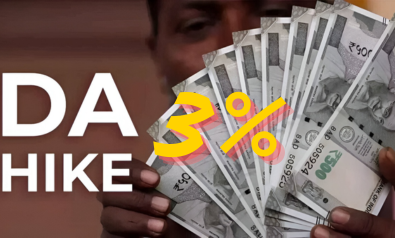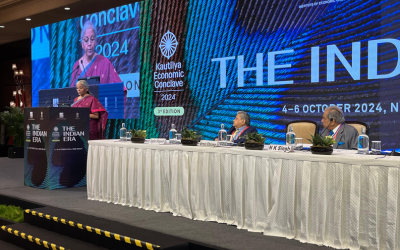Table of Contents
ToggleCabinet Approves 3% DA Hike for Central Government Staff and Pensioners
The Union Cabinet, led by Prime Minister Shri Narendra Modi, has sanctioned an additional instalment of Dearness Allowance (DA) for Central Government employees and Dearness Relief (DR) for pensioners, effective from July 1, 2024. This approval represents a 3% increase over the current rate of 50% of the Basic Pay/Pension, aimed at offsetting the impact of inflation.
This adjustment follows the established formula recommended by the 7th Central Pay Commission. The total financial burden on the exchequer due to this increase in DA and DR is estimated to be Rs. 9,448.35 crore annually.
Approximately 49.18 lakh central government employees and 64.89 lakh pensioners will benefit from this increase.
Impact on Employees and Pensioners
The increase in DA and DR is a significant relief for central government employees and pensioners, especially in the face of rising living costs. The additional 3% hike will help mitigate the effects of inflation, ensuring that the purchasing power of employees and pensioners is maintained. This move is particularly timely, coming ahead of the festive season, providing a financial boost to over 1 crore beneficiaries.
Economic Implications
The financial implications of this decision are substantial. The combined impact on the exchequer is projected to be Rs. 9,448.35 crore per annum. This increase is part of the government’s ongoing efforts to support its employees and pensioners, reflecting its commitment to their welfare. The adjustment is based on the Consumer Price Index for Industrial Workers (CPI-IW), which tracks inflation trends and ensures that the DA and DR adjustments are in line with the cost of living.
Historical Context
Dearness Allowance and Dearness Relief are revised biannually, in January and July, to keep pace with inflation. The most recent adjustment prior to this was a 4% increase announced in March 2024, which raised the DA to 50% of the basic pay. The 7th Central Pay Commission’s recommendations have been instrumental in shaping these adjustments, ensuring that they are fair and reflective of current economic conditions.
Government’s Commitment
This decision underscores the government’s commitment to its employees and pensioners. By regularly adjusting the DA and DR, the government aims to provide financial stability and support to its workforce. This move is also expected to have a positive impact on the economy, as increased disposable income can lead to higher consumer spending, thereby stimulating economic growth.
Conclusion
The approval of the 3% DA hike for central government employees and pensioners is a welcome move that addresses the challenges posed by inflation. It highlights the government’s proactive approach in ensuring the financial well-being of its employees and pensioners. As the festive season approaches, this increase will undoubtedly bring cheer to many households, reinforcing the government’s dedication to its workforce.
🔴 #BREAKING : केंद्रीय कर्मचारियों को बड़ा तोहफा, DA में की गई 3% की बढ़ोतरी#DA | #DAHike pic.twitter.com/lXTqkNSYP5
— NDTV India (@ndtvindia) October 16, 2024
The Evolution of Dearness Allowance: A Historical Perspective (DA Hike)
Dearness Allowance (DA) is a critical component of the salary structure for government employees and pensioners in India. It serves as a cost-of-living adjustment allowance, aimed at mitigating the impact of inflation on the earnings of public sector employees. The history of DA is rich and reflects the economic and social changes in India over the decades.
Origins of Dearness Allowance
The concept of Dearness Allowance was introduced during the Second World War. Initially known as the “Dear Food Allowance,” it was designed to help employees cope with the rising cost of living due to wartime inflation. In 1947, the “Old Textile Allowance” was introduced, which was later revised and reintroduced in 1953 as the “Revised Textile Allowance”.
Linking DA to the Consumer Price Index
Initially, DA was granted in response to demands for wage revisions. However, it was later linked to the Consumer Price Index (CPI) to ensure a more systematic and fair adjustment to inflation. The Third Central Pay Commission (CPC) recommended that DA be paid whenever the CPI rose by 8 points over the base index of 200 (with 1960 as the base year). This linkage ensured that DA adjustments (DA hike) were directly tied to changes in the cost of living.
Central Pay Commissions and DA Adjustments
Over the years, various Central Pay Commissions have reviewed and revised the DA structure:
- Third CPC (1973): Recommended DA adjustments based on an 8-point rise in CPI, with neutralization ranging from 100% to 35%.
- Fourth CPC (1986): Introduced a percentage system for DA calculation and recommended biannual adjustments.
- Fifth CPC: Advocated for uniform neutralization of 100% for all employees, addressing disparities between different levels of employees.
- Sixth CPC: Revised the base year for DA calculation to 2001 and recommended frequent updates to the base year.
Recent Developments
In October 2021, the government revised the Consumer Price Index for Industrial Workers (CPI-IW) base year from 2001 to 2016. This change aimed to reflect more current economic conditions and ensure that DA adjustments remain relevant and fair.
Significance of DA
Dearness Allowance plays a crucial role in protecting the real income of government employees and pensioners from the eroding effects of inflation. By linking DA hike to the CPI, the government ensures that employees’ purchasing power is maintained, thereby contributing to their financial stability and well-being.
The history of Dearness Allowance is a testament to the Indian government’s efforts to safeguard the economic interests of its employees. From its origins as a wartime measure to its current form, DA hike has evolved to become a vital component of the salary structure for public sector employees. As inflation continues to impact the cost of living, DA remains a crucial tool in ensuring that government employees can maintain their standard of living.
Examples of how Dearness Allowance (DA HIKE)
Recent 3% DA Hike (2024)
In October 2024, the Indian government announced a 3% increase in DA for central government employees and pensioners, raising it from 50% to 53% of the basic pay. For an employee with a basic pay of ₹18,000, this hike translates to an additional ₹540 per month, increasing their DA from ₹9,000 to ₹9,540. This adjustment helps employees cope with rising living costs, providing a financial buffer against inflation.
Impact of the 7th Central Pay Commission (2016)
The 7th Central Pay Commission (CPC) significantly revised the DA structure. It recommended that DA be revised twice a year, in January and July, based on the Consumer Price Index (CPI). This change ensured that employees’ salaries were more closely aligned with inflation rates. For instance, an employee with a basic pay of ₹20,000 saw their DA increase from 125% to 132% over a year, resulting in an additional ₹1,400 per month.
DA Freeze During COVID-19 (2020-2021)
During the COVID-19 pandemic, the Indian government decided to freeze DA and Dearness Relief (DR) for central government employees and pensioners from January 2020 to June 2021. This freeze was implemented to manage the economic impact of the pandemic. While this decision temporarily halted the increase in DA, it was resumed in July 2021 with a substantial hike to compensate for the freeze period.
Historical DA Adjustments (1986)
The 4th CPC in 1986 introduced a percentage system for DA calculation and recommended biannual adjustments. This change was significant as it standardized the DA calculation process and ensured regular updates. For example, an employee with a basic pay of ₹5,000 in 1986 saw their DA increase from 10% to 15%, providing an additional ₹250 per month.
These examples illustrate how DA adjustments have played a crucial role in maintaining the purchasing power of government employees, ensuring their salaries keep pace with inflation and economic changes.



